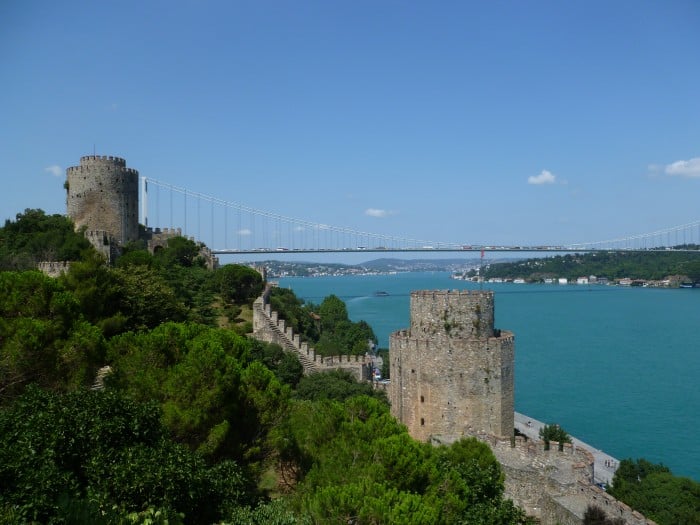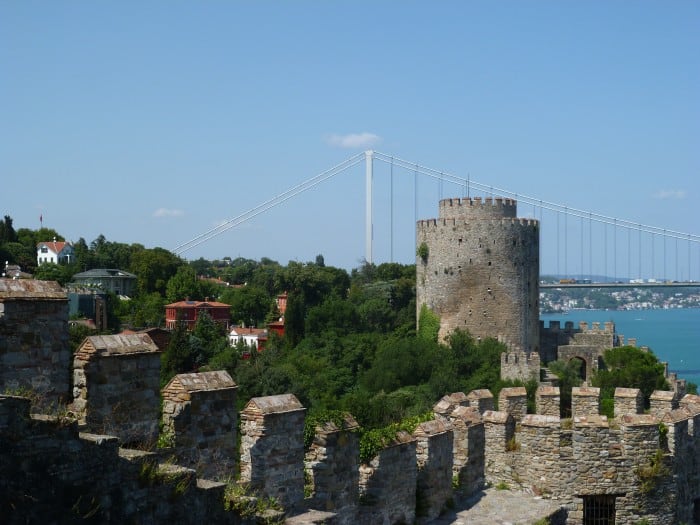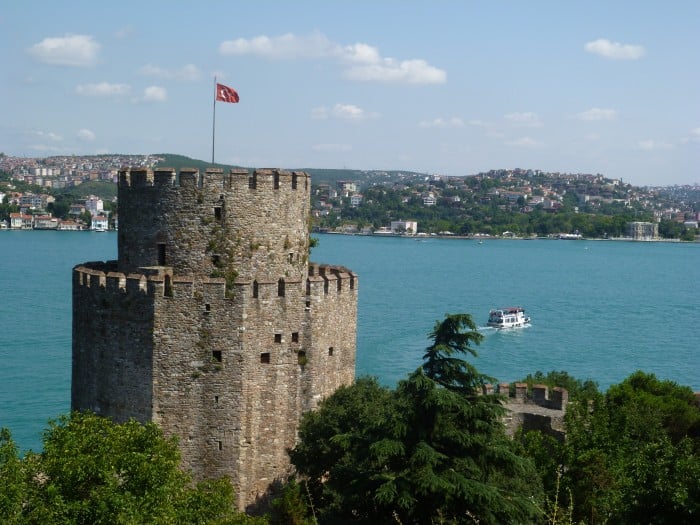
Although the Bosphorus is the real star of Istanbul, its beauty is accentuated by the city’s monuments, those sturdy shapes that mediate between the ever shifting sea and sky. There is the Aya Sofya, Topkapı Palace, and the Blue Mosque, which anchor Sultanahmet and are the quintessential Istanbul sites. Then there are the two bridges spanning the Bosphorus, the very tangible embodiments of Turkey as a bridge between Europe and Asia.
Yet one of the most magnificent monuments to grace the strait, Rumeli Hisarı, is often overlooked and underrated. Most people experience Rumeli Hisarı from a distance, snapping a flurry of photos while on a Bosphorus cruise. Such a perspective certainly allows one to comprehend the immensity of this Ottoman fortress, whose highest tower stands at 92 feet tall and whose walls stretch for 820 feet from north to south. But to gain a deeper appreciation of Rumeli Hisarı and its relation to the city, a visit to the site itself is in order.
Rumeli Hisarı played a crucial role in the conquest of Constantinople by Sultan Mehmed II, later known as Mehmed the Conqueror, in 1453. Construction of the fortress began in April 1452, shortly after Mehmed II’s second ascent to the throne in 1451 (he had previously ruled from 1444 to 1446). Prior to the siege of Constantinople, which at the time served as the seat of power for the Byzantine empire, the Ottomans had gained control over most of western Anatolia and a large portion of former Byzantine lands in Thrace, making significant headway into the Balkans. In effect, the Ottomans had the Byzantine capital surrounded.

It can be difficult to gain an accurate picture of these events, to imagine a city so unlike the one we currently occupy. Yet standing at Rumeli Hisarı, with nothing to distract you, it’s possible to envision a Bosphorus that was in large part removed from the city, as Constantinople in those times was concentrated in the Golden Horn. The strait was crucial for transport and trade, but the areas further north along the Bosphorus, those areas that now are an integral piece of the cityscape, were so removed from the center, so much a part of the periphery that they could be used by the Ottomans to plan and execute an attack on the Byzantine empire. This historical perspective is enforced by the quiet and solitude of the fortress, which sits in sharp contrast to the modern parade of cars and ships and people passing by.
To further sequester the city, the last remnant of a once extensive empire, Mehmed II oversaw the incredibly quick construction of Rumeli Hisarı. Located at the narrowest point of the Bosphorus and opposite Anadolu Hisarı, which Sultan Bayezid I had commissioned at the end of the 14th century, Rumeli Hisarı was built with the intention of controlling the traffic along the strait and to ensure that aid from the Latin city-states did not reach the Byzantines during the Ottomans’ conquest. With such aims, it is clear why the fortress was initially called Boğaz Kesen, which translates to “cutting the Bosphorus” (or literally “cutting the throat”, since boğaz means “throat” in Turkish). Even though it occupies the narrowest point along the strait, when looking out from Rumeli Hisarı the Asian shore still seems unreachable, making these defenses even more incredible and the Ottomans’ success even more captivating.

The sheer size of Rumeli Hisarı, the speed with which it was built and its central role in the conquest of Constantinople by Mehmed II illustrate the significance of this fortress for the city and contribute to its allure. Although the site has little in the way of adornments outside of some decrepit cannons, and provides only very basic commentary on the fortress’s history, it offers a large green hillside to roam and walls to climb. This freedom to explore unencumbered by explanations and without crowds of tourists creates a space for reflection on Istanbul’s beauty and its past. It is attractive in its simplicity.
In short, Rumeli Hisarı is one of those thin places described by Eric Weiner, where one’s relationship with time is altered, softened even. He warns against letting guidebooks or friends recommend so-called thin places and rightly so. As such, I don’t want to imply that your visit to Rumeli Hisarı will yield the same reaction. Rather, I suggest that this fortress, with its views and its vastness and its important place in Ottoman history, is one monument glittering along the Bosphorus that is worth a second look.
Its closed on mondays.
Editor’s Note: This post was originally published in February of 2013 by Emma Harper. It was updated for relevance on February of 2023.











I have passed by Rumeli Hisarı all the time but have never visited. Where exactly is the entrance?
Also, there are great views of the towers from the top of Borusan headquarters just up the street at the Perili Köşk which is open to the public on weekends, http://www.borusancontemporary.com/museum.aspx
I live in Bebek, a short walk from Rumeli Hisar and have taken friends there often. I am now in the U.S. for medical reasons and miss the sight of R.H. very muich
Beautifully written – thanks! I must go to visit!
[…] you roll yourself out of Kale, make a visit to Rumelihisarı a few feet away. The fortress is an Istanbul attraction that has a shot at remaining refreshingly […]
[…] Feneri castle is just one of several fortresses positioned on the coast (Rumeli Hisarı and Anadolu Hisarı are two prominent examples) which were gradually built up throughout the […]